Where To Upload Homebrew Dnd Campaign
- About
- Latest Posts
![]()
Latest posts by Karyl Trejo (see all)
Dungeons and Dragons is one of the nigh popular tabletop games in the world, boasting an estimated 13.seven million players worldwide. First released in 1974 , the game has gone through many iterations, with ruleset changes ranging from tweaks to redesigns in order to make the game easier and more fun to play.
While D&D is one of the earth'southward starting time mainstream TTRPGs, the game differs from many others in the genre by the sheer freedom information technology offers players.
While Dungeons and Dragons has ever had an official setting, called the Forgotten Realms, as well as officially published races, classes, backgrounds, and other character creation cloth to cull from, the rules of D&D have never limited players to just published materials.
Under the framework of the D&D ruleset, players are able to play with game material that they've created themselves . In the D&D fan community, fan-fabricated game material is referred to as "homebrew." Homebrew tin can include fabric such as:
- Campaigns
- Settings
- Races
- Classes
- Backgrounds
- Feats
Some of the best D&D campaigns have featured homebrew rules, and the ability to create your own material is i of the reasons why D&D has remained the near popular tabletop role-playing game in the world since its release.
So, whether y'all're an experienced D&D fanatic or a beginner only starting to enter the world of Dungeons and Dragons, here'due south everything you need to know almost homebrew.
History of D&D Homebrew
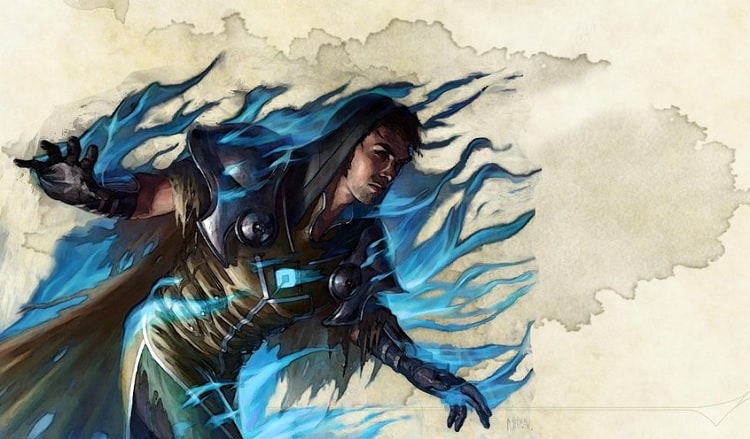
Outside of D&D, the term "homebrew" is an English discussion that typically refers to alcoholic beverages, usually beer, that are brewed at dwelling house rather than by a professional brewery. Homebrew drinks allowed apprentice brewers to add their ain preferred twists and flavors to their booze, rather than having to cull from the limited options at the store.
Since 2003, D&D fans accept been using the term "homebrew" to refer to homemade game material. The first use of the term in this context is most oft attributed to an online user by the username of "kexizzoc87." This user described his custom D&D entrada as his "homebrew campaign" on a web forum to distinguish information technology from official campaign materials.
By 2005, Wizards of the Coast (the company which caused Dungeons and Dragons in 1997 from founding company TSR) had begun using the term in articles on its official website. While the term "homebrew" may have but been used since 2003, bootleg content has been used in Dungeons and Dragons since the inception of the game in 1974.
In fact, the game has actually required role player-made game material since the very first official release, with the Men and Magic source booklet, published with the original release of the game, stating that "…the referee must draw out a minimum of half a dozen maps…" when explaining the rules of a particular campaign for the game.
While initially Dungeons and Dragons merely officially encouraged players to brand their own game materials for published source material, that didn't cease players from making their own content correct off the bat.
Nevertheless, while the game was under the purview of TSR, the visitor retained trademark rights over the source material of the game so players were precluded from using homebrew material that borrowed from the official source material in any official setting.
This changed upon the acquisition of D&D past Wizards of the Coast . With the release of the third edition of the game, WoTC released their trademark rights to a significant portion of the game under an Open Gaming License, which allowed fans to create and fifty-fifty sell homemade D&D textile without needing permission from WoTC or paying royalties.
By 2017, WoTC had released the website D&D Beyond , which functioned as an official online database for players to submit and share homebrew material with the rest of the fanbase.
Differences Between Homebrew and Unearthed Arcana
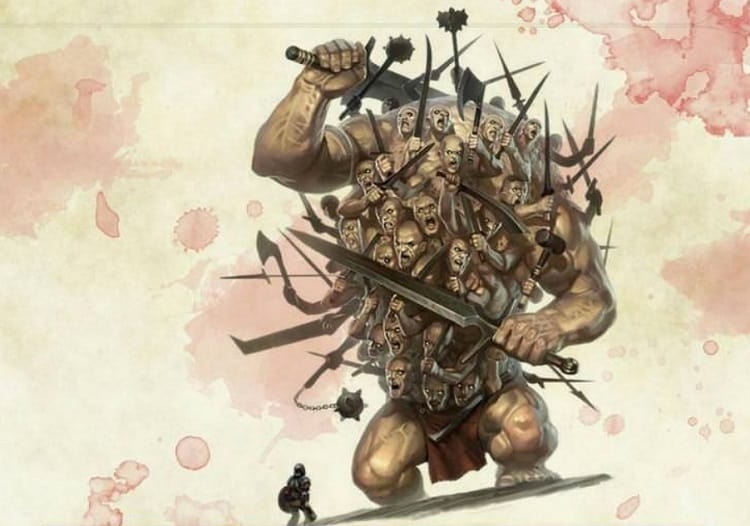
When talking about any unofficial D&D source material, there are two different categories that must be distinguished from i another:
- Homebrew
- Unearthed Arcana
First, there's homebrew, which refers to whatsoever fan-made D&D source material. So there'south what WoTC calls " Unearthed Arcana ," which refers to D&D source textile released by WoTC for the purposes of playtesting in preparation for an official release.
In essence, Unearthed Arcana is fabric that has been created by Wizards of the Declension, only is not set up to exist officially published in a sourcebook and therefore non official D&D source material yet.
Unearthed Arcana has not undergone the rigorous playtesting that WoTC uses to ensure published materials are fair, non-gamebreaking, and balanced. This playtesting occurs at official D&D events, merely the cloth is released online for everyone to try out in the meantime.
Some notable recent Unearthed Arcana releases for D&D 5E include:
- Draconic Options
- Folk of the Feywild
- Gothic Lineages
- Spells and Magic Tattoos
- UA: Feats
Homebrew, on the other mitt is entirely created by players, and will never be officially tested or produced by WoTC themselves. This means that homebrew is usually less mature compared to both Unearthed Arcana and any officially published materials. That does not mean that homebrew is inherently worse than official materials, though.
While homebrew commonly doesn't take the reward of existence played by millions of people with professionals analyzing how the fabric interacts with all the other material published for the game, creators of homebrew are often extremely defended and take neat pains to ensure their homemade content is fun and as balanced as possible.
Advantages and Disadvantages of Homebrew
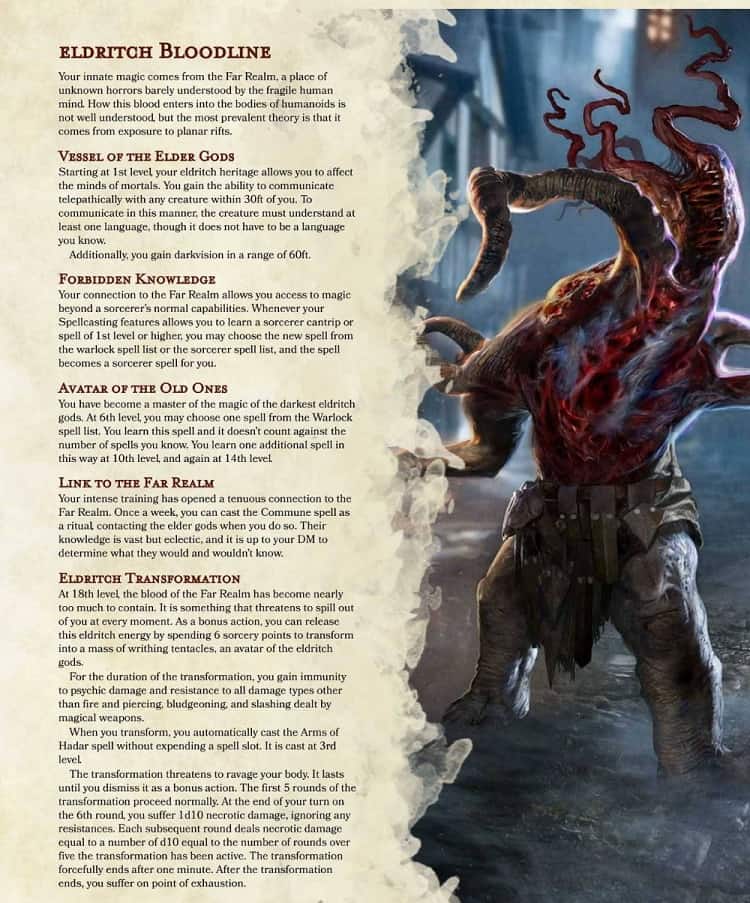
Of course, as popular as homebrew is, at that place are some pros and cons of using it. Let'south go ahead and weigh some of those now.
The Advantages of Homebrew
- Homebrew game material allows players to attain their wildest dreams in the world of Dungeons and Dragons, ranging from flavored races with some tweaks to completely new form ideas.
- If you lot wanted to play a vampire necromancer or a half-Celestial detective, you can create those character options under the D&D ruleset and play out whatever your imagination tin can recollect up.
The Disadvantages of Homebrew
- Creating completely untested game material without guidelines or limitations can obviously have meaning problems if you want to have a counterbalanced entrada with actual dangers and limitations. Almost Dungeon Masters require players to submit homebrew well in accelerate for campaigns for approval, if they even allow homebrew fabric at all.
- Creating whatsoever kind of original counterbalanced homebrew presents immense challenges. D&D under any edition involves a huge and complicated fix of rules, and determining how character features and new rules interact with every other published rule is near impossible to do for a single person.
- Even WoTC depends on data from millions of actual players playtesting new material to come across how new classes and races change the balance of the game.
- An apprentice creating homebrew material tin can accidentally end up creating vastly overpowered or underpowered characters, disrupting the balance of the game and making it less fun for themselves or other players.
That'due south not to say that you shouldn't utilise homebrew, or that you need to be a D&D proficient to create your own homebrew.
What y'all practice need to keep in mind though, is that any homebrew cloth must exist approved by your DM. They might choose to make changes to your homebrew rules in order to increment or decrease your graphic symbol's ability level, or remove your homebrew from the game entirely if they remember it's affecting the enjoyment of others.
How to Create Your Own Homebrew
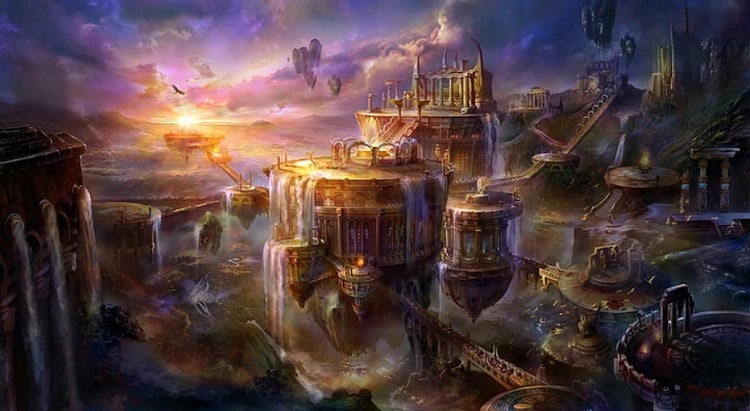
And then, how can you create homebrew with a amend chance of avoiding the pitfalls mentioned earlier? That depends on what kind of material you're trying to create.
Homebrew campaign settings or lore don't actually usually bear on the dynamics of the game, as they're just additional flavor for the players to exist in. Rather, a homebrew campaign requires a bit more attending, since you'll need to be mindful of the power levels of unlike leveled characters and change the power levels of the enemies in the campaign accordingly.
By non doing that, y'all run the adventure of your players slaughtering their way through your advisedly constructed campaign effortlessly, or, conversely, dying in a total party kill in the offset twenty minutes.
Classes and races are the most difficult to create, since they directly affect the ability level of characters. Even so, no matter what kind of homebrew material you're trying to brand, you should follow these three guidelines:
- Be familiar with the D&D Ruleset for the edition y'all're playing
- Identify patterns in how published playtest material is designed
- Understand how strengths and weaknesses are balanced
First, you should accept a practiced knowledge of the rules of D&D. This doesn't mean you need to memorize every sourcebook. However, a general knowledge of published classes and races , too as published campaigns (and enemies), are very helpful to use equally a sort of guideline.
Next, you'll need to understand how published material is balanced. When we talk well-nigh balance, nosotros're talking about finding the ideal signal when combining strengths and weaknesses for your grapheme or the campaign, where the game is functioning as intended. Your character isn't besides strong or also weak, and the campaign isn't also difficult or too easy.
While balancing a earth for your characters normally merely involves decreasing or increasing the stats of the enemies your players run into, balancing races, or even worse, classes, can be much more tricky. Races and classes affect graphic symbol features in ii main ways: by either raising ability scores, or providing diverse powers.
In order to create a balanced race or class, you need to consider how your new grapheme features interact with published character features (ie. other races and classes, as well as feats and magical items) and how they compare with the power levels of other races and/or classes.
Additionally, if you're making a new form, yous'll have to consider how that form's power level increases as the grapheme levels up. Ideally, you want a homebrewed race or class to be similar in ability level to other published races or classes. You can achieve this by controlling the traits granted past your homebrew.
For races, D&D 5E typically has an established pattern for how races grant bonuses. Ordinarily, you gain +one or +two to i, two, or 3 stats, sometimes pre-selected and sometimes up to the thespian's choice, as well as proficiency in i language and some racial features such as darkvision and trance.
Races too give boosted bonuses such as walking, swimming, or flying speeds. It's of import that you endeavour to balance these traits and then that your race isn't more or less powerful than other races. For example, the published elf race has lots of racial features, such as trance and darkvision, but only i racial ability score increase, +2 to Charisma.
When designing a new form, you should also attempt to keep the power level of your new class similar to other published classes. Classes rarely actually impose negative furnishings on characters. Rather, y'all should be careful to tweak the relative strength of abilities your homebrew grade grants.
For instance, you might choose to grant one high-power ability at 1st Level, followed by ii low-power abilities at 2nd Level, or two high-power abilities at 1st level and one low-power power at the second level.
Of form, the relative strength of abilities is difficult to judge in isolation, and how your new rules interact with other rules published in the game is very difficult to decide on your ain without active playtesting.
An easier way to create homebrew is to tweak or reskin existing abilities, rather than creating make new ones. This mode, you get to create the unique season of whatever yous want to play, while still leaning on existing material and abilities to forbid yourself from accidentally creating something overpowered/underpowered.
At the finish of the day, creating homebrew should be nearly creativity and calculation flavor and uniqueness to the game, rather than trying to create powerful new classes to sneak by your DM.
As e'er, remember that all homebrew textile needs to be approved by your DM before you can use it. Some DMs may disallow homebrew entirely! By creating homebrew materially responsibly, you can help ensure homebrew continues to be immune at your local table or game.
The Very Best of Homebrew
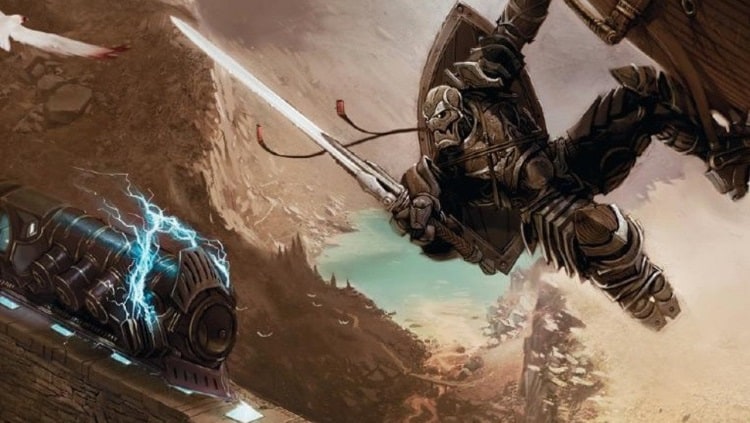
As is always the case with player-created cloth, the quality of homebrew you lot'll find online will vary drastically. Some homebrew creations have go incredibly pop amidst the D&D community, and accept been used in a big variety of campaigns and games with thespian-feedback.
Other homebrew textile might have been haphazardly tossed together by some child on a ability trip that renders characters utterly unplayable. There are a multifariousness of websites where you can notice online homebrew material that people all around the world have shared.
These include the following:
- DM's Guild
- DnD Beyond
- Kobold Printing
While you can probably find all sorts of homebrew cloth on various fan forums and communities, homebrew institute on a reputable source like the websites above tend to have more idea put into them, and are therefore more probable balanced and playable.
While some homebrew on reputable sites is shared with the community for costless, others tin can crave purchase to use. Homebrew material is still technically someone else's intellectual property, and you shouldn't use someone else's piece of work without permission.
While all homebrew can be imaginative and inspirational, hither are some of our favorite works of D&D homebrew for 5th Edition that you tin can add to your campaign.
Homebrew Campaigns

Campaign settings and run a risk material provide a globe and/or storyline for your characters to play within. All officially published campaign material occurs within the Forgotten Realms, unremarkably on the continent of Faerun, with legendary locations such as the Sword Coast.
Three of the more pop homebrew campaigns include:
- Call from the Deep
- Into Wonderland: A Feywild Setting Book
- Eyes Unclouded
Some of the more than seasoned D&D veterans know that sometimes playing in the same quondam places with the same quondam high-fantasy flavor gets a piddling old. Hither's a closer wait at the three homebrew campaign books that will take your players on adventures beyond their wildest dreams… with unimaginable dangers also.
Call From the Deep
Written by popular Dungeon Primary's Guild contributor JVC Parry, Call from the Deep is a completely new risk book that takes players on a fantastical adventure through the familiar and iconic Sword Coast, albeit with some very unfamiliar visitors.
An ethereal send, otherworldly pirates, and other eldritch horrors await your players in a unique and heady story. The adventure book is filled with unique and beautiful art and maps, as well as high-quality homebrewed monsters, magic items, and graphic symbol options, as well every bit make new encounters and locations.
Your players will be sure to embark on a voyage they'll never forget when they hear the Phone call from the Deep.
Into Wonderland: A Feywild Setting Book
I of our favorite settings in the published world of D&D is the feywild. There's something well-nigh the dazzler and wonder of the place, non to mention the horrors it contains, that has always spoken to me.
Problem is, there'due south scarcely a published campaign that actually lets players travel to the Feywild! That is, until now. Experienced homebrew writer William Rotor finally brings players into the world of the Feywild in his campaign setting book, Into Wonderland .
The book takes players into the terrible majesty of the unknown, where magic fills every crevice in a world where fairy tales come to life.
The book contains a fully homebrewed city setting for players, new rules to add together to the game and new storylines and enemies, every bit well every bit new races, subclasses, backgrounds, feats, and spells, all carefully homebrewed for a DM to start a campaign with or add to an existing game.
Optics Unclouded
Japanese animation is world-renowned for producing some of the greatest animation works in the earth, with studios such every bit Studio Ghibli producing fan-favorites that have won the hearts of millions.
If you're a fan of archetype Japanese animation, you'll detect no better homebrew campaign volume than Eyes Unclouded , a bright anthology of adventures for D&D 5E inspired by works of archetype Japanese animation. From fortresses in the sky to an ancient curse-afflicted forest, Eyes Unclouded is i of the most creative gamble modules ever made.
The book contains eleven original adventures designed to bring players from 1st to 14th Level, with original art, storylines, and encounters. There are even 8 custom recipes in the back inspired by the hazard book that fans can make at domicile to snack on during late-night D&D sessions.
Homebrew Races
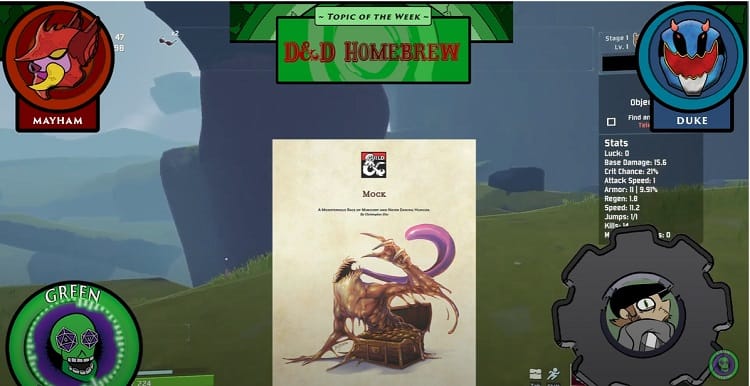
Races are 1 of the near commonly homebrewed game elements and tin can add a ton of flavor into the game. Homebrew races allow players to enact all sorts of different character ideas and backstories.
These homebrew races include:
- Abomination
- Animated Armor
- Fairy
A good homebrew race should be balanced in terms of bonuses, offer plenty of season and possibility for graphic symbol cosmos, and be well adult and fleshed out. Here are some of the best player-made races on D&D Beyond.
Abomination
Fans of the work of H.P Lovecraft and other classic pieces of existential horror may have often dreamed of playing a character with a truly harrowing backstory, the Anathema offers the perfect chance to do so.
Abominations are members of other races that accept gone through such unspeakable trauma that they've had their previous racial traits stripped from them and turned into living monsters .
While some abominations might struggle against their transformation and others might comprehend information technology, there's no denying the inherent hunger and malice in the Abomination. This homebrew race offers a huge variety of possible backstories and personality traits, all overtly dark and disturbing of course.
The race also includes some fun racial traits, such as shapechanger and eldritch claret, which both offer fun season and mechanics for characters. The race is also decently balanced, albeit on the stronger side, with an ability score increase of +one in strength, dexterity, and intelligence as well as a variety of features.
Blithe Armor
If you've ever wanted to play a living suit of armor, yous'll be happy to know that someone'due south created a full-fledged D&D race to exercise and then! Animated Armors are magical beings, capable of being created in whatever shape or size.
Although they may non take sensory organs in the conventional sense, they tin experience the world around them through magic simply as well every bit your average adventurer of flesh and blood.
Although animated suits of armor may seem a tad scary, a fact that the creator of this homebrew did non neglect to include in its racial traits, playing as a suit of armor offers some unique advantages, including the power to lie dormant for hundreds of years and superhuman (well, really not-human) immovability.
This means that your Blithe Armor character can take all sorts of fantastic backstories. The racial traits of the Animated Armor are jam-packed with flavour, and with +1 in Constitution and +ane in Forcefulness/Dexterity and a diverseness of subraces, the race offers a lot of options for graphic symbol creation.
Fairy
Whether y'all've e'er dreamed of being a fairy prince/princess, a mischievous trickster (or simply an otherworld spirit), this homebrew fairy class is just the thing for y'all!
With a well-developed history, plenty of flavour in its features such as invisibility, shrink and tiny hands, besides equally some very playable ability score increase options like +2 in dexterity and +1 in Constitution/Charisma/Strength /Wisdom, this homebrew fairy race is the offers a huge range of backstory and character options.
The entire race is likewise centered around a nature theme, very fitting for fairies, with interesting and unique subraces. You can cull to be a cute butterfly fairy, a fantastical dragonfly fairy, an elegant moth fairy, or a hardy beetle fairy.
This homebrew fairy race is a perfect blend of flavor, playfulness, and just enough silliness to really boom the esthetic of being a classic fantasy fairy.
Homebrew Classes
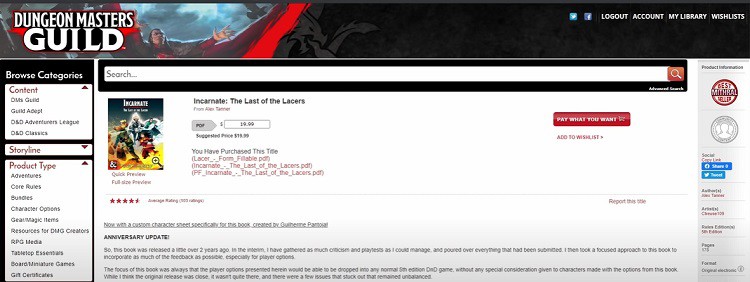
Probably the most iconic kind of homebrew material, homebrew classes make upward the vast majority of homebrew content on the internet. Classes touch a D&D character the about of all the parts of grapheme cosmos.
Furthermore, they can unlock abilities through the entirety of an adventure equally a player levels upward, meaning they're exceptionally difficult to create and rest. Fortunately, that also means people spend the nearly effort creating homebrew classes, leading to some fantastic options, detailed below.
The Claret Hunter
Mayhap the most well-known piece of homebrew content in the entirety of D&D 5E, the Claret Hunter class, created by famous D&D streamer Matthew Mercer, is one of the virtually well-crafted and balanced homebrew classes ever made, so much and so that the form is featured on D&D'due south official website, despite remaining outside the official release of the game.
With a completely unique class ability and mechanics, a huge amount of flavor and potential for backstories — as well as astonishing balancing and complication for a homebrew class — you'll scarcely detect a better selection if y'all want to play a class outside the traditional D&D roundup.
The Dr.
Another incredibly unique form idea, the Doctor , written by Reddit user EarlGrey, a popular D&D homebrew content creator, the class adds the niche of a non-magical healer to the D&D class roster.
The class is incredibly well thought up, with plenty of flavor woven into its abilities, which are all impressively playable without existence overpowered. The class also features some unique mechanics and abilities that all come together into a highly well idea-up and entertaining class to play.
Frequently Asked Questions
Question: Where can I Observe good D&D Homebrew?
Answer: You can notice tons of great homebrew textile that other passionate players accept made on online platforms, such as Reddit, Twitter, Pinterest, Imgur, and others, as well every bit D&D'due south ain homebrew sharing platform, D&D Beyond.
If you're willing to pay for homebrew textile, the DM's Guild and Kobald Print sites are highly reputable sources for quality homebrew material.
Question: What Tools can I Utilise to Make Homebrew?
Answer: There are all sorts of online tools you can employ to write and format homebrew material, including D&D Beyond and The Homebrewery, an open-source tool that helps you lot to create homebrew that looks incredible and professional.
Equally for actually writing D&D homebrew content, having access to published sourcebooks helps a lot, as well as request online community forums on platforms such as Reddit for advice or feedback.
Question: Should I Play with Homebrew in my Game?
Respond: It depends. If y'all're new to playing D&D, or are a new DM, information technology can be difficult to gauge whether or not whatever given piece of homebrew material is balanced enough to play every bit written, or how to tweak homebrew to residual information technology.
Homebrew tin can also be a bit more than complicated to play, so beginners to the game should probably stay away. If you really want to play with something new and are okay with potential gamebreaking risks, nonetheless, then absolutely! Merely exist sure you okay any homebrew material with the DM beforehand.
Question: Is Homebrew Material Allowed for Official D&D Events?
Answer: No, homebrewed content is not role of the official release of the game and therefore is non permitted at D&D Adventurers League events or other official events unless otherwise stated by event organizers.
Question: How Long does it Take to Write Homebrew Material?
Answer: The time it takes to write homebrew can vary wildly between authors based on experience, complexity and but how smoothly the artistic process goes for whatever given project.
Like all artistic endeavors, some homebrew projects tin can take years to end, while others are written in a affair of days. It all depends on the individual author and how circuitous the homebrew is.
Our Last Thoughts
Homebrew is one of the reasons why D&D continues to persist as i of the most popular TTRPGs in the world, and why the game remains so fresh and vibrant fifty-fifty after nearly fifty years since its first publication.
With D&D homebrew, the characters and stories you can play out are only limited past your imagination, and then get out there and start making your wildest dreams come to life right on the board!
Source: https://explorednd.com/homebrew/
Posted by: smithhakis1990.blogspot.com


0 Response to "Where To Upload Homebrew Dnd Campaign"
Post a Comment